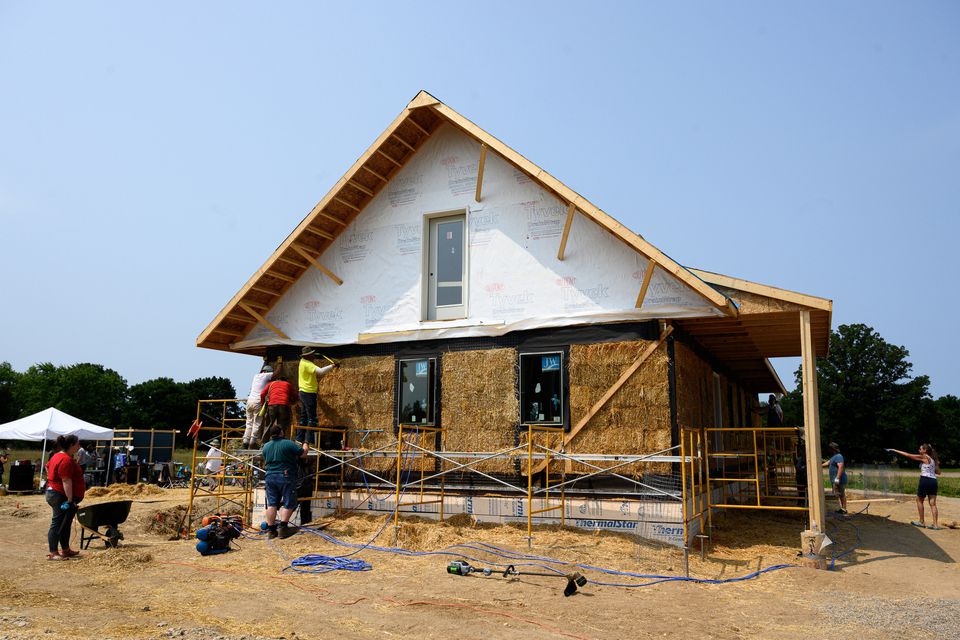A week long straw bale workshop near Ann Arbor, Michigan had 43 participants. “Building a straw bale home isn’t much different than a conventional home,” said Andrew Morrison, who created the workshop. “It uses regular foundations and floor frames, with posts and beams, and from there, workers stuff straw bales into the walls instead of synthetic products like foam. Once the bales are placed between the frames, they’re wrapped in mesh, sewn together and shaved down. Then three layers of plaster are applied, concealing and protecting the straw,” he said.
“I’m passionate about natural building,” workshop participant Bruce Curtis said. “I can’t stand how houses have been built for generations and the waste of energy, especially with global warming — the houses aren’t helping us with their gas usage.”
Andrew hosts six straw bale construction workshops per year and participants travel from around the world to attend. But he doesn’t want to just build houses. He wants to build a community, Morrison said. During the week-long workshop, participants eat meals together and camp near the site. After nine hours of work, they gather around the fire to eat, drink and play music.
“There’s something about building a community,” Morrison said. “That’s something lost in general construction. The idea of getting people together like this and working together and sweating together to create something beautiful is important.”
There are no conventional heating or cooling units in the straw bale house they worked on. The roof and windows are strategically designed to keep the home cool during the summer and warm in winter. A masonry stove helps in winter, along with hot water tubes running through the floors, heated by rooftop solar panels.
“It’ll cost you more to build it, but when you live in it for so many years, you’re saving 75 percent on heating and cooling per year,” Morrison said. “If you live in an area that gets cool at night, you don’t need an air conditioning unit. You just open a window at night.”
If built correctly, straw bale homes can have the same longevity as a conventional house.
The one built last week took 320 straw bales to construct.
“The home includes a basement and greenhouse,” said Selena Lucas, who will live in the house with her husband and child. “And the straw doesn’t create a fire hazard,” she said. “Even if flames got through the three thick layers of plaster, there would be no oxygen within the walls for the fire to grow,” Lucus said.“The outside will be scorched, but the inside will be fine.”
Morrison said there’s also an extra sense of comfort that comes with thick walls and natural materials.
“There’s a sense of achievement that comes with building (the house) and helping the environment,” Curtis said. “You feel like you’re doing something more than something for yourself.”
You can read the original article at www.mlive.com

Congratulations to Andrew Morrison for running such a successful workshop in Ann Arbor. I’ve just been reading the Wikipedia entry for the city. Judging by the monthly climate statistics, a particularly challenging area to design a building that will deal with everything. January a grim month with half of the days featuring snowfall, and December to February inclusive with negative temperatures. July is the hottest month in an average year, but also the wettest. Yet the coldest June to August inclusive have featured temperatures just over freezing ! I would suspect that nice thick straw walls are probably an ideal medium to cope with such a temperature range, and a seemingly unpredictable range at that ! I gather that Ann Arbor, being home to the World famous University of Michigan, has encouraged self-builds, particularly those featuring innovative designs. An excellent project that Andew Morrison has been hosting, and lets wish everyone there well with this and other projects of sustainable builds. If they can do it with challenging conditions – many of the rest of us can if we make the effort ! Thanks for the fascinating article !
Why would anyone build out of straw bale??? Ever read the three little pigsra
Straw bales make easy building blocks that have excellent insulating properties. They can be used either as infill for insulation or they can be stacked and be load bearing. They are an agricultural by-product that have very little embodied energy, and are a very sustainable solution for construction. If they are utilized with care and proper attention to detail, they can produce housing that will last as long and be as strong as most other traditional techniques.
I really do Not want to live in such house!
Imagine what happen when you have fire, hurricanes or tornado, and this kind of house can not be considered as energy saving! Instead filling the walls with straw why don’t you fill it with foam concrete which is fire proof, high thermal isolation , water proof and very strong!
We are in 21st century !
Well, as explained in the article, straw bale walls do not burn easily, and if they are designed and built right they can withstand high winds. Straw is at least as good at insulating as foam concrete and it is a natural material with very low embodied energy, better than cement.